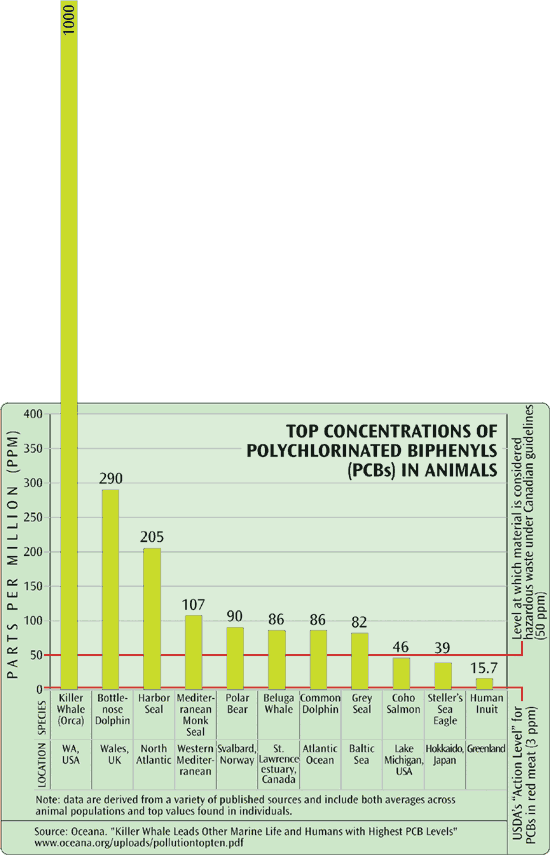
Over 70,000 new chemicals have been brought into commercial production and released to the environment in the last 100 years.
15 million Americans have a PBDE (Polybrominated Diphenyl Ether) body burden of more than 400 ppb (parts per billion); a hundred times the concentration known to cause permanent effects in laboratory animals. [2]
 As of 1994, over 50 million tons of radioactive PCB contaminated wastes were
As of 1994, over 50 million tons of radioactive PCB contaminated wastes werein storage awaiting disposal. Radioactive PCB wastes were being generated
at a rate in excess of 5 million tons per year.[3]
 |
| Both the USA and Canada have over 200 million tons of uranium tailings which retain 85% of their original radioactivity. |
Text Sources
1. US Environmental Protection Agency, http://www.epa.gov/oppt/chemtest/hazchem.htm
2. Environmental Working Group, http://www.ewg.org/reports/taintedcatch/part3.php
3. EPA Management of Polychlorinated Biphenyls in the US; http://www.chem.unep.ch/pops/indxhtms/cspcb06.html
Chemicals Table Sources
Column 2. "Late lessons from early warnings: the precautionary principle 1896-2000." Europen Environment Agency Environmental issue report No 22 http://reports.eea.eu.int/environmental_issue_report_2001_22/en/tab_content_RLR
UNEP General Program of Action for the Protection of the Marine Environment from Land Based Activities “History of Persistent Organic Pollutants" http://pops.gpa.unep.org/04histo.htm;
US EPA http://www.epa.gov/history/topics/perspect/lead.htm;
London Hazards Centre http://www.lhc.org.uk/members/pubs/books/asbestos/asb13.htm
Column 3. "Late lessons from early warnings: the precautionary principle 1896-2000." Europen Environment Agency Environmental issue report No 22 http://reports.eea.eu.int/environmental_issue_report_2001_22/en/tab_content_RLR
US EPA "Persistent Organic Pollutants: A Global Issue, A Global Response" http://www.epa.gov/international/toxics/pop.htm
Environmental Working Group http://www.ewg.org/reports/taintedcatch/part1.php
EPA http://www.epa.gov/history/topics/lead/02.htm
LaDou, Joseph. "The Asbestos Cancer Epidemic" Environmental Health Perspectives Volume 112, Number 3, March 2004 http://ehp.niehs.nih.gov/members/2003/6704/6704.html
Column 4. US EPA Integrated Risk Information System (IRIS) http://www.epa.gov/iris/index.html
US Occupational Safety & Health Administration (OSHA) http://www.osha.gov/dts/chemicalsampling/toc/toc_chemsamp.html
Column 5. EPA web site http://www.epa.gov/history/topics/pcbs/01.htm;
UNEP General Program of Action for the Protection of the Marine Environment from Land Based Activities “History of Persistent Organic Pollutants" http://pops.gpa.unep.org/04histo.htm and New York Times February 23, 2002 http://query.nytimes.com/gst/abstract.html?res=F 70E13F93B5A0C708EDDAB0894DA404482&incamp=archive:search
UK Pesticide Safety Directorate http://www.pesticides.gov.uk/approvals.asp?id=55 and UNEP General Program of Action for the Protection of the Marine Environment from Land Based Activities “History of Persistent Organic Pollutants" http://pops.gpa.unep.org/04histo.htm
Column 6. US EPA Integrated Risk Information System (IRIS) http://www.epa.gov/iris/index.html
US Occupational Safety & Health Administration (OSHA) http://www.osha.gov/dts/chemicalsampling/toc/toc_chemsamp.html
This page originally published at: The Global Education Project